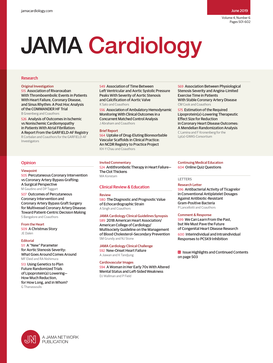Contributions of Common, Rare, and Somatic Genetic Variants to Incidence of Atrial Fibrillation
IF 14.1
1区 医学
Q1 CARDIAC & CARDIOVASCULAR SYSTEMS
引用次数: 0
Abstract
ImportanceAtrial fibrillation (AF) has a complex genetic architecture involving common, rare, and somatic variants. The association between these components requires further investigation.ObjectiveTo examine the individual and combined contributions of polygenic, monogenic, and somatic genetic variants to AF incidence, and develop an integrated genomic model (IGM-AF) for improved risk prediction.Design, Setting, and ParticipantsThis cohort study used whole-genome sequence data from participants of the UK Biobank, with follow-up for AF events through hospital records, death registries, and self-report. The UK Biobank recruited participants aged 40 to 69 years in the UK between 2006 and 2010. Study data were analyzed from August 2022 to November 2024.ExposuresIGM-AF comprising an AF polygenic risk score (PRS), a composite rare variant gene set (AFgeneset), and somatic variants associated with clonal hematopoiesis of indeterminate potential (CHIP). Clinical AF risk was estimated using the Cohorts for Heart and Aging Research in Genomic Epidemiology AF (CHARGE-AF) score.Main Outcomes and MeasuresThe primary outcome was hazard ratios (HRs) for 5-year incident AF attributable to PRS, AFgeneset, CHIP, and their interactions. The predictive performance of IGM-AF and its components was quantified using HRs, C statistics, and reclassification indices.ResultsA total of 416 085 individuals (mean [SD] age, 56.6 [8.0] years; 224 642 female [54.0%]) with 30 797 AF cases were included. The PRS (HR per 1 SD, 1.65; 95% CI, 1.63-1.67;常见、罕见和躯体遗传变异对房颤发病率的影响
房颤(AF)具有复杂的遗传结构,包括常见、罕见和躯体变异。这些组件之间的关联需要进一步研究。目的探讨多基因、单基因和体细胞遗传变异对房颤发病率的个体和综合影响,并建立一个综合基因组模型(IGM-AF),以改进风险预测。设计、环境和参与者本队列研究使用来自英国生物银行参与者的全基因组序列数据,并通过医院记录、死亡登记和自我报告对房颤事件进行随访。英国生物银行在2006年至2010年间在英国招募了40至69岁的参与者。研究数据分析时间为2022年8月至2024年11月。暴露igm -AF包括AF多基因风险评分(PRS)、复合罕见变异基因集(AFgeneset)和与不确定潜力克隆造血(CHIP)相关的体细胞变异。临床房颤风险使用基因组流行病学心脏与衰老研究队列(CHARGE-AF)评分进行评估。主要结局和测量主要结局是由PRS、AFgeneset、CHIP及其相互作用引起的5年AF事件的风险比(hr)。采用hr、C统计量和重分类指数对IGM-AF及其组分的预测性能进行量化。结果共纳入416085例(平均[SD]年龄56.6[8.0]岁,女性224 642例(54.0%)),其中AF病例30 797例。PRS (HR / 1 SD, 1.65; 95% CI, 1.63-1.67; P & lt; 1 × 10−8)、AFgeneset (HR, 1.63; 95% CI, 1.52-1.75; P = 1.46 × 10−42)和CHIP (HR, 1.26; 95% CI, 1.15-1.38; P = 1.41 × 10−6)与AF事件相关。与仅有1个驱动因素的个体相比,具有所有3个遗传驱动因素(常见、罕见和体细胞驱动因素)的个体5年累积AF发病率至少为2倍。与单独使用IGM-AF和CHARGE-AF相比,IGM-AF联合临床风险模型(CHARGE-AF)具有更高的预测性能(C统计值为0.80;95% CI为0.80-0.80)。将IGM-AF加入CHARGE-AF后,AF高危人群的分类得到改善(净重分类指数,0.08;95% CI, 0.07-0.09)。结论和相关性本队列研究的结果表明,常见、罕见和体细胞变异在形成房颤基因组风险方面具有互补价值。利用全面的遗传信息可以加强房颤的筛查和预防干预。
本文章由计算机程序翻译,如有差异,请以英文原文为准。
求助全文
约1分钟内获得全文
求助全文
来源期刊

JAMA cardiology
Medicine-Cardiology and Cardiovascular Medicine
CiteScore
45.80
自引率
1.70%
发文量
264
期刊介绍:
JAMA Cardiology, an international peer-reviewed journal, serves as the premier publication for clinical investigators, clinicians, and trainees in cardiovascular medicine worldwide. As a member of the JAMA Network, it aligns with a consortium of peer-reviewed general medical and specialty publications.
Published online weekly, every Wednesday, and in 12 print/online issues annually, JAMA Cardiology attracts over 4.3 million annual article views and downloads. Research articles become freely accessible online 12 months post-publication without any author fees. Moreover, the online version is readily accessible to institutions in developing countries through the World Health Organization's HINARI program.
Positioned at the intersection of clinical investigation, actionable clinical science, and clinical practice, JAMA Cardiology prioritizes traditional and evolving cardiovascular medicine, alongside evidence-based health policy. It places particular emphasis on health equity, especially when grounded in original science, as a top editorial priority.
 求助内容:
求助内容: 应助结果提醒方式:
应助结果提醒方式:


